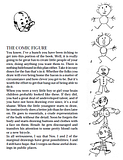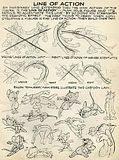So glad you made this thread.
I'm a bit busy tonight, so I'll just start with a quick flyby on fundamentals, pose dynamics and lining.
Now, one of the most common errors beginning artists--especially those who get their start by tracing/copying--make, is that they see only the outline and details, and fail to grasp the underlying anatomy and general composition:

In a word, they're the monocoque construction to the Gundam Mk. II's movable frame. Why is this a problem, I hear you ask? Because the energy, volume, "bounce" of the drawing comes from how you initially lay out the figure. Observe:

I just want to reiterate here, because even a technically correct drawing can come out very flat and stiff if you don't pay attention:

This is why professional art training emphasizes three-dimensional shapes before lines, as well as 'gesture sketches': quick sketches of live, moving targets, aimed not so much at a perfect rendition but capturing the energy and direction of the subject. You can somewhat emulate the experience using
Posemaniacs.
So that's the 50,000-feet-up overview of fundamentals and why they're important. What happens after you're capable of constructing figures with life? Here's a nice little note on inking that I present without comment because I simply can't improve on the explanation:


Next time: Color theory, and I actually say more than a couple sentences per picture!